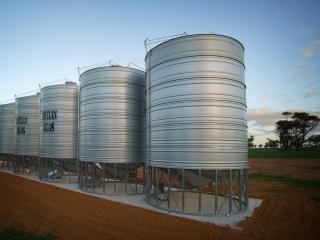Clean augers, field bins and silos to prevent insects contaminating grain
Winter is the best time to do a thorough check and clean out of empty storage and grain handling equipment. During the cooler months of the year, grain insect activity is at its lowest, breeding is almost non-existent and flight does not occur therefore improving the efficacy of any hygiene measures undertaken.
Residual pest populations surviving in empty storages during winter will infest new season grain when it is put into the storages. If eradication of these pests is not undertaken, they may undergo selection for resistance as a result of repeated fumigations.
The Western Australian grain storage industry is focused on sealed storage and fumigation to achieve the federally mandated ‘nil tolerance’ for live insects in exports.
Gas-tight sealable silos are the preferred system of storage and pressure testing silos needs to be part of the annual maintenance. It is much easier to replace seals and carry out repairs when silos are empty. Inspection and replacement if necessary of inlet and outlet seals as well as checking pressure relief oil valves and topping up with light hydraulic oil if needed is recommended.
Augers, field bins and silos should be thoroughly cleaned of grain residues and treated with a structural treatment. The ground around storages should be cleared of weeds and rubbish to prevent harbouring insects. Old grain residues should be burned or buried deep.
Be aware of withholding periods if you are treating the inside of an empty silo with a registered insecticide such as fenitrothion, to provide residual control before the grain is loaded. Non-chemical products such as diatomaceous earth (e.g. Dryacide) need at least two weeks before loading grain to be effective.
Dryacide is a naturally occurring insecticide and will provide good control for at least 12 months. It is a non-toxic, diatomaceous earth product that is recommended as a structural treatment.
Nitrogen can be used on its own or in combination with other fumigants for effective insect control but requires a very high level of sealing on the silo and the silo to be initially purged along with very high levels of silo sealing to maintain an environment free of oxygen.
Growers are reminded that the insecticide fenitrothion is not registered as a seed treatment. Fenitrothion is a contaminant in exported grain. Growers using Fenitrothion as a structural treatment in the weeks prior to harvest should leave the chemical in place for 2-3 days and then wash it off to prevent contamination of any grain that may come into contact with the sprayed surface. Diatomaceous earth is the preferred for in-silo structural treatments.
Phosphine is the cheapest form of insect control at around 40c/tonne but growers need to be sure their silo is a gas-tight sealable silo meeting Australian Standards AS2628-2010.
It is good practice to pressure test sealed silos upon erection, annually and before fumigating with a five-minute half-life pressure test. See the GRDC supported Stored grain information hub website for more details on pressure testing.
In order to kill grain pests at all stages of their life cycle (egg, larvae, pupae, adult), growers should refer to the phosphine label instructions regarding dosage, treatment, ventilation and withholding times.
Poor fumigation can result in only adult and larval insects being killed giving the mistaken impression that the fumigation was successful. However, the immature eggs and pupae will not be killed and infestations will likely build up again quickly, selecting for resistant populations.
Fumigating in an unsealed silo or field bin is an off label use, it is not only ineffective, at best killing adults and larvae, it will also lead to strong resistance developing on your farm.
Phosphine inhalation is very serious and can be fatal. Always read the Safety Data Sheets, always wear protective clothing including chemically resistant gloves and a full-face respirator with a B category cartridge. Inform others (including putting up a phosphine warning sign) when a storage facility is under fumigation.
Managing phosphine resistance
Insect populations with weak phosphine resistance have developed in all grain-growing states of Australia largely as a result of poor fumigations. Strong resistance is widespread in the eastern states and has started to take hold in the west, so to help minimise the development of strong resistance to phosphine in WA, use well maintained gas-tight sealable silos.
Detecting phosphine resistant grain pests early will make eradication possible and will protect your income. To arrange a free resistance test for grain pests contact Sam Manning, DPIRD stored grain insect group, South Perth on +61 (0)8 9368 3561.
Farmers keeping grain on farm for their own use, with silos that are not sealed can use aeration as an alternative method to keep insects in low numbers.
Aeration cooling is an effective tool which can be used in combination after fumigation for maintaining insect population control. While aeration cooling will not kill insects, it will dramatically reduce reproduction provided aeration fans are used in combination with an aeration controller to selectively push cool dry air through the grain in the silo at a rate of 2-3 litres per second per tonne.
For more information on stored grain management techniques visit;
- GRDC supported website; Stored grain information hub
- GRDC’s Hygiene and structural treatments for grain storage factsheet.
- DPIRD’s Sealed silos make sense page
- DPIRD's Insect pests of stored grain page.
For more information contact Sam Manning, Technical Officer, South Perth on +61 (0)8 9368 3561 or Ben White, GRDC grain storage extension team WA on 1800 WEEVIL (1800 933 845).
Original article author: David Cousins (DPIRD South Perth).
Article updated by: Oonagh Byrne (DPIRD South Perth) and Ben White (GRDC).

